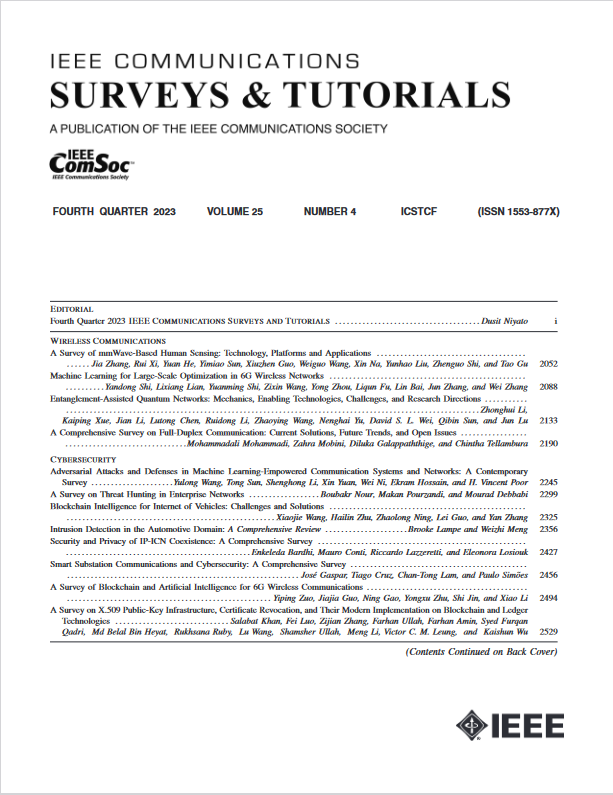社会化学习:网络系统边缘智能范式转变概览
IF 34.4
1区 计算机科学
Q1 COMPUTER SCIENCE, INFORMATION SYSTEMS
引用次数: 0
摘要
在人工智能(AI)和大数据的强劲推动下,边缘智能(EI)已经成为一种新兴的计算范式,将人工智能与边缘计算(EC)相结合,成为释放人工智能服务全部潜力的典范解决方案。尽管如此,通信成本、资源分配、隐私和安全方面的挑战继续限制其在支持具有不同需求的服务方面的熟练程度。针对这些问题,本文引入社会化学习(social learning, SL)作为一种有希望的解决方案,进一步推动EI的发展。SL是一种基于社会原则和行为的学习范式,旨在增强EI系统内主体的协作能力和集体智慧。SL不仅增强了系统的适应性,而且还优化了通信和网络流程,这对于跨不同设备和平台的分布式智能至关重要。因此,SL和EI的结合将极大地促进未来网络中协同智能的发展。本文介绍了EI与SL集成的文献综述,总结了EI与SL的最新研究成果。随后,我们全面探讨了EI的局限性以及EI如何从SL中受益。特别强调了这些系统中的通信挑战和网络策略等方面,强调了优化网络解决方案在提高系统效率方面的作用。在此基础上,我们详细阐述了社会化架构、社会化训练和社会化推理三个组成部分,并分析了它们的优缺点。最后,我们确定了SL和EI结合的一些可能的未来应用,讨论了开放的问题,并提出了一些未来的研究建议,希望引起研究界对这个新兴的、令人兴奋的跨学科领域的兴趣。本文章由计算机程序翻译,如有差异,请以英文原文为准。
Socialized Learning: A Survey of the Paradigm Shift for Edge Intelligence in Networked Systems
Amidst the robust impetus from artificial intelligence (AI) and big data, edge intelligence (EI) has emerged as a nascent computing paradigm, synthesizing AI with edge computing (EC) to become an exemplary solution for unleashing the full potential of AI services. Nonetheless, challenges in communication costs, resource allocation, privacy, and security continue to constrain its proficiency in supporting services with diverse requirements. In response to these issues, this paper introduces socialized learning (SL) as a promising solution, further propelling the advancement of EI. SL is a learning paradigm predicated on social principles and behaviors, aimed at amplifying the collaborative capacity and collective intelligence of agents within the EI system. SL not only enhances the system’s adaptability but also optimizes communication, and networking processes, essential for distributed intelligence across diverse devices and platforms. Therefore, a combination of SL and EI may greatly facilitate the development of collaborative intelligence in the future network. This paper presents the findings of a literature review on the integration of EI and SL, summarizing the latest achievements in existing research on EI and SL. Subsequently, we delve comprehensively into the limitations of EI and how it could benefit from SL. Special emphasis is placed on the communication challenges and networking strategies and other aspects within these systems, underlining the role of optimized network solutions in improving system efficiency. Based on these discussions, we elaborate in detail on three integrated components: socialized architecture, socialized training, and socialized inference, analyzing their strengths and weaknesses. Finally, we identify some possible future applications of combining SL and EI, discuss open problems and suggest some future research, with the hope of arousing the research community’s interest in this emerging and exciting interdisciplinary field.
求助全文
通过发布文献求助,成功后即可免费获取论文全文。
去求助
来源期刊

IEEE Communications Surveys and Tutorials
COMPUTER SCIENCE, INFORMATION SYSTEMS-TELECOMMUNICATIONS
CiteScore
80.20
自引率
2.50%
发文量
84
审稿时长
6 months
期刊介绍:
IEEE Communications Surveys & Tutorials is an online journal published by the IEEE Communications Society for tutorials and surveys covering all aspects of the communications field. Telecommunications technology is progressing at a rapid pace, and the IEEE Communications Society is committed to providing researchers and other professionals the information and tools to stay abreast. IEEE Communications Surveys and Tutorials focuses on integrating and adding understanding to the existing literature on communications, putting results in context. Whether searching for in-depth information about a familiar area or an introduction into a new area, IEEE Communications Surveys & Tutorials aims to be the premier source of peer-reviewed, comprehensive tutorials and surveys, and pointers to further sources. IEEE Communications Surveys & Tutorials publishes only articles exclusively written for IEEE Communications Surveys & Tutorials and go through a rigorous review process before their publication in the quarterly issues.
A tutorial article in the IEEE Communications Surveys & Tutorials should be designed to help the reader to become familiar with and learn something specific about a chosen topic. In contrast, the term survey, as applied here, is defined to mean a survey of the literature. A survey article in IEEE Communications Surveys & Tutorials should provide a comprehensive review of developments in a selected area, covering its development from its inception to its current state and beyond, and illustrating its development through liberal citations from the literature. Both tutorials and surveys should be tutorial in nature and should be written in a style comprehensible to readers outside the specialty of the article.
 求助内容:
求助内容: 应助结果提醒方式:
应助结果提醒方式:


